Today, I took Doryman out for a run around Perdido Bay in the Tom Cat 255. After a little over half an hour and 8 miles running, the Port engine quit. Warren suggested that I outline what I did to diagnose and reslove the issue.
I had changed the filters about 50 hours ago--and checked the fuel and water separator last time I used the boat--but had not drained it today. We have also recently added ethanol fuel at local stations. I had added Startron, Pri G, and Stabil (fuel stabilizer) about 3 months ago. Recently I had filtered the fuel in the tank of the boat I use almost frequently--and 18 foot center counsel--and put about 15 gallons of that fuel, plus 15 gallons of new fuel into each of the Tom Cat's tanks.
First, I drained the Racor filter clear base. Based on what I found there, I pulled the racor filter. There was definate water mixed with the fuel, as well as some flocculant in the base of the filter. I attempted to restart the engine, and was not successful. Since we were only several miles from my home, I elected to return to base, instead of resloving the issue on the spot. The reason was: I knew I would have to drain and prime the entire fuel system. I didn't want to drop any parts over board in the bay, where there was a little chop. I didn't want to spill the contaminated fuel (or any fuel) into the bay. At home I have a can for disposal of bad fuel.
After pulling the engine cover, I found that there is a fuel water separator at the back of the engine. This is under a shroud, which moves back and pulls up to clear the fuel water separator. The separator, is held in place by rubber retainers, and can be pulled free. There is a cap on the bottom of the separator which can be removed by removing the clip with pliers.
After this was drained, I then followed the fuel line to where it entered the injection pump, pulled that, and then flushed out the entire line until clean fuel was coming through. The engine fired right up and ran up to full RPM under load.
Tomorrow, I will filter all of the fuel in both tanks with my polishing system. I have to assume that there is still water in the tanks--and this needs to be removed as best as can be done. There may be a small amount of residual water below the pickup.
Lesson, I should have changed fuel filters more often, and should drain the water separator on the Racor each time we go out. There was a slight feeling that the engine was missing as I accelorated. I should have stopped right there and changed filters--but I also should have drained the fuel water separator on the engine every 50 hours, as well as the Racor. I do carry 4 extra fuel filters, and gaskets sets. I did replace the other engine's filter.
One other observation. We ran back at various speeds. To achieve 1 gallon an hour, we were going slightly over 4 knots. To achieve 7 knots--the max speed without lugging the engine, we were only getting about 1.1 miles a gallon! So going only 7 knots in the Tom Cat is an extremely ineffecient speed.
Photos of the fuel water separater and fuel lines on the Suzuki 150 (and 175) First is the shroud over the fuel water separator. Next shroud off, showing the fuel water separator. Next the separator out of its retainer and the cap pulled off, then the front of the engine and finally,showing where the pliers remove the clamp on the fuel hose going into the injector pump.
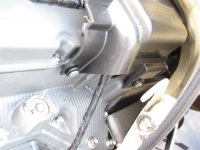
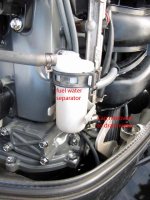
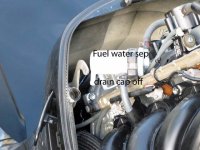
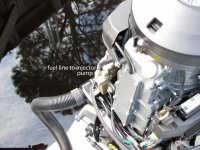
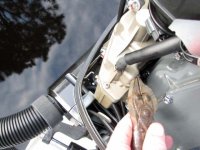
I had changed the filters about 50 hours ago--and checked the fuel and water separator last time I used the boat--but had not drained it today. We have also recently added ethanol fuel at local stations. I had added Startron, Pri G, and Stabil (fuel stabilizer) about 3 months ago. Recently I had filtered the fuel in the tank of the boat I use almost frequently--and 18 foot center counsel--and put about 15 gallons of that fuel, plus 15 gallons of new fuel into each of the Tom Cat's tanks.
First, I drained the Racor filter clear base. Based on what I found there, I pulled the racor filter. There was definate water mixed with the fuel, as well as some flocculant in the base of the filter. I attempted to restart the engine, and was not successful. Since we were only several miles from my home, I elected to return to base, instead of resloving the issue on the spot. The reason was: I knew I would have to drain and prime the entire fuel system. I didn't want to drop any parts over board in the bay, where there was a little chop. I didn't want to spill the contaminated fuel (or any fuel) into the bay. At home I have a can for disposal of bad fuel.
After pulling the engine cover, I found that there is a fuel water separator at the back of the engine. This is under a shroud, which moves back and pulls up to clear the fuel water separator. The separator, is held in place by rubber retainers, and can be pulled free. There is a cap on the bottom of the separator which can be removed by removing the clip with pliers.
After this was drained, I then followed the fuel line to where it entered the injection pump, pulled that, and then flushed out the entire line until clean fuel was coming through. The engine fired right up and ran up to full RPM under load.
Tomorrow, I will filter all of the fuel in both tanks with my polishing system. I have to assume that there is still water in the tanks--and this needs to be removed as best as can be done. There may be a small amount of residual water below the pickup.
Lesson, I should have changed fuel filters more often, and should drain the water separator on the Racor each time we go out. There was a slight feeling that the engine was missing as I accelorated. I should have stopped right there and changed filters--but I also should have drained the fuel water separator on the engine every 50 hours, as well as the Racor. I do carry 4 extra fuel filters, and gaskets sets. I did replace the other engine's filter.
One other observation. We ran back at various speeds. To achieve 1 gallon an hour, we were going slightly over 4 knots. To achieve 7 knots--the max speed without lugging the engine, we were only getting about 1.1 miles a gallon! So going only 7 knots in the Tom Cat is an extremely ineffecient speed.
Photos of the fuel water separater and fuel lines on the Suzuki 150 (and 175) First is the shroud over the fuel water separator. Next shroud off, showing the fuel water separator. Next the separator out of its retainer and the cap pulled off, then the front of the engine and finally,showing where the pliers remove the clamp on the fuel hose going into the injector pump.





